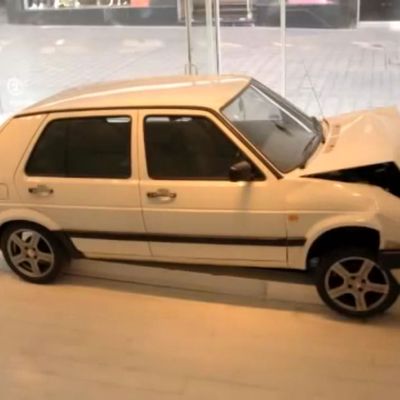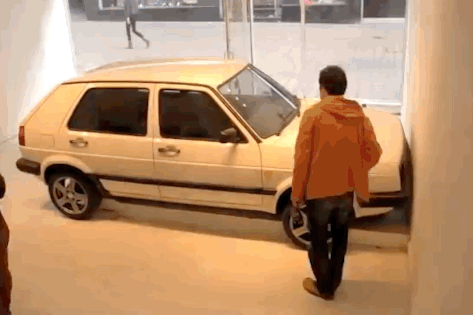
Artist Jonathan Schipper has personally never been in more than a fender bender, and these days he lives in Brooklyn and doesn’t even own a car, but one of his most well-known works is Slow Motion Car Crash, which is just what it sounds like: a car, attached to a hydraulic piston, being unhurriedly but implacably mashed into a wall. Think of it as an impact safety test, minus the crash-test dummies and at molasses speed. Thanks to Pierogi Gallery, you’ll be able to see it at the Armory Show the first week of March, compacting itself over four days.
So what is it about a car wreck? “My interest in it was that this pivotal emotional moment,” Schipper says. “It happens so damn fast, and you have so much adrenaline,” that its hard to apprehend. So why not slow it down? “We’ve all seen a million slow-motion crashes in Hollywood. But this one you can touch.”
It’s part of a series Schipper, who is originally from California, has been working on for the past ten years. “The original piece was a head-on collision, which is called The Slow Inevitable Death of American Muscle,” he says. A portentous title, perhaps, but he chose the muscle cars for their powerful, specific cultural pull: “They did such a great job of reflecting the aspirations of a generation,” he says. And in any case, its hard to argue that these have been the best years for American muscle (in the larger sense of military and economic self-assurance) around the world. (And for what its worth, it was around the time that Quentin Tarantino made his muscle-car snuff film Death Proof.) The project has been put on as far away as China.
Muscle was an edition of three: To create it, for example, a Pontiac Firebird and a Chevy Camaro have both been deployed to commit drawn-out auto murder-suicide. One edition of it is owned by an heir to the Jack Daniel’s fortune (appropriately enough, since part of what this reminds you of is those banged-up-by-driving-drunk car-carcasses suburban police sometimes display as a scare tactic), and sits in front of a restaurant and art space made out of a former gas station in Louisville, Kentucky. They have it set to very slow: “They’ve only changed the cars out twice, I believe.”
“I still get almost weekly hate mail from the muscle-car world, who think it’s an attack on them: ‘How could you destroy these wonderful cars?’” In reality, the cars he buys, on which he never spends more than $2,000, are usually barely street-legal.
Actually, at the Armory, he’d originally hoped to up the ante with a slow-motion airplane crash, but it proved too unwieldy (not to mention, these days, evocative of terrorism).
So it was back to the single-car version, which he has done several times before in gallery spaces. It’s cheaper, and simpler to pull off, and has slightly different implications: of cars crashing into buildings, or perhaps just our own inevitable mortality. “We empty out all of the gas and fluids and electrical batteries, take the air out of the tires, and all that. The nice thing is that cars are engineered to be safe in an accident. We put a safety film over the windows; the side windows sometimes break.” The hydraulic cydinder pushes at 20,000 pounds. The three to four days “is as fast as we’ve done it, basically,” he says. “When you’re actually there, this is a nice speed. You can see a small difference in an hour. So it’s kind of fun to watch.”
He’ll buy a car — he’s hoping to get a Mini Cooper — on Craigslist the week before. And it ought to be a popular diversion at the fair: After all, probably the most-Instagrammed artwork at Art Basel Miami Beach this year was Jimmie Durham’s Still Life with Xitle and Spirit: a junker crushed by a big volcanic basalt rock (the car was an old Chrysler Spirit; Xitle is a volcano in Mexico).
“I’m a conceptual artist, a sculptor,” he says. “General America gives us a lot of flak. But this gets a lot of public acceptance. It’s kind of like a special effect, in a way, which is easy to get into. It’s kind of like watching fire, when you sit around watching fire. It’s so captivating: You’re watching something die, it’s contemplative.”
Here is an earlier iteration of it, sped up:





